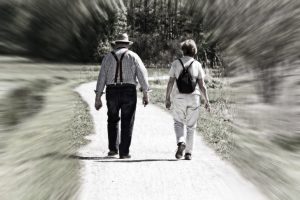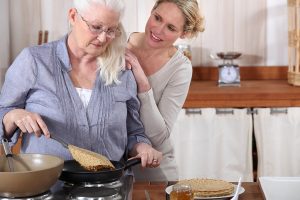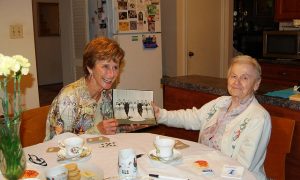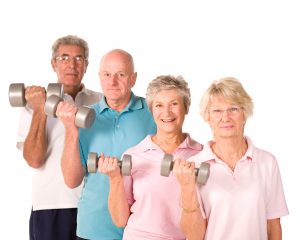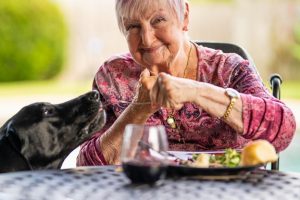Guest Blog: Romance can spark retirement planning
Romance is an exciting prospect to pursue during the retirement years. In fact, a study conducted by Merrill Lynch and Age Wave revealed that 69% of retirees find romantic activities a priority during the golden years.
Of course, proper retirement planning is needed in order for couples to make time for love. It can’t be stressed enough that 70% of people age 65 years and above is expected to receive some form of long term care in the future. And a long term care insurance (LTCI) basically covers that particular need.
Now, the great thing about planning early for long term care is that not only will partners be able to receive care when they need it. Couples preparing together can also strengthen their relationship. A stronger bond with each other effectively prevents any arguments that spouses may encounter in the future. Planning, in a way, sets one’s hopes and expectations for the romantic ride in the next couple of years.
As a couple, setting your sights on some romantic retirement activities can be a motivational tool for you both to prepare for your tomorrows. Here are some suggestions you may want to do together:
Travel
Experience unforgettable moments by exploring new places. It doesn’t need to be far – the important thing is you’re together in a strange and exciting place!
Higher Education
Bring back the wonders of school romance by pursuing higher education. Aside from having the chance to pass love notes in class, the knowledge gained from school can be used for possible business opportunities during retirement.
Movies
Retirement means more time with each other. So grab some popcorn and enjoy watching some romantic movies together.
Cooking
Food is the way to a man’s (or even a woman’s) heart. Enjoy whipping up some meals for each other.
Health
Keeping fit is better when done with a partner. Even something as simple as walking together in a park should keep you and your date fit and happy.
Go on a Date
Even single retirees can join in the fun. Retirement can be a good time to meet, mingle, and spend time with a new and special friend.
And the list goes on. No matter which activity you and your spouse may want to do, an LTCI will grant the security in case something dire happens. Make sure to get a suitable LTC coverage for your romantic retirement getaways today.
Author Bio: Violet Swenson is the Online Content Director at LTC Global Agency, a reliable provider of long term care insurance since 2002. Our strong partnerships with top companies across the country help us deliver the most competitive products in the industry.
Guest Blog: How Do Seniors With Alzheimer’s Handle Change?
When seniors develop diseases affecting cognition, like the various kinds of dementia, caregivers typically make an effort to make their living environment as safe and comfortable as possible. Sometimes caregivers make lots of changes to a senior’s living space, with the best intentions of helping them. However, this can have a two-sided effect, because seniors with mentally deteriorating illnesses can find change to be a confusing or frightening thing. Caregivers might change the entire layout of a house, remove everything that could be a hazard, or add numerous locks to provide security. Changes like these can actually prove to be disorienting for a senior, in addition to being helpful. So the question becomes, how much change can seniors with Alzheimer’s handle?
It’s typical to find instances where seniors have lived in the same home for decades, and have a curious ability to navigate the living space with a sort of muscle memory after memory-harming diseases like Alzheimer’s set in. Routine is very important to the delicate psyche of an elder with dementia, so finding the perfect balance of what to change for their own good can be tricky. Making abrupt overwhelming makeovers to their home’s layout can make them flustered and end up actually making it more difficult for them to get around, adding to their impaired cognition. So it is best to maintain an environment that is familiar as much as possible. And make any alterations subtly and slowly over time.
The necessity to make changes will depend of the severity of a senior’s individual case. If the Alzheimer’s is in the mid to late stages and a senior is wandering out of the home constantly, then immediate action to prevent hazard is surely appropriate. Installing door alarms or adding locks can be great helps. If a senior with dementia typically kept a messy household, then the mess may add to their unease or make it easier to trip and fall. De-cluttering their living space can be advantageous in these cases.
Thus, change will surely be necessary at times. Though it is advisable to make changes as gradually and calmly as possible, to avoid overwhelming or distressing what was comfortable, normal, and assuring to the mind of a loved one with dementia. Routine is key for security in these instances. It may also be helpful to make sure you let them see when you move something, or set their things some place, to help then more easily adapt to the change.
Guest Blog: Tips for Making a Home Safer for Seniors
With growing age, keeping up with daily activities can become difficult. Aging seniors cannot do basic chores like cooking and cleaning and even moving around in their homes can sometimes become difficult. Taking care of your aging parents is a noble task, but due to current lifestyles, it has become challenging for children to take care of parents. Since you cannot be with them 24/7, you can change at home to make their lives easier and to avoid accidents. The good news is, now you can get help with your senior care in Dallas or any other city across cities across the nation. There are great options for senior care to simplify and improve your life, putting everyone’s mind at ease.
Here are five of the top things you can do to make life easier for seniors living in their own homes.
- Create a fall free zone.
Older people have increased risks of falling or slipping even from the smallest things. The following simple changes can reduce the chances of tripping:
- Install a cordless or cell phone instead of using a traditional telephone.
- Remove throw rugs from the home, as they can be hazardous for people using walkers.
- Place electrical cords for the TV, modem, and telephone should correctly to avoid tripping.
- Obtain an alarm bracelet or necklace that sends alert to emergency services with a push-button.
- Encourage the use of a cane or a walker at all times instead of holding onto walls and furniture.
- Purchase non-slippery footwear or flat, thin-soled shoes that fit well.
- Change floorings from tiles to wooden.
- Create a secure place for pets, so that they do not clutter things in the hallway or the living room.
- Teach older adults fire safety tips
The kitchen is a potential area where seniors are at risk of getting burnt. Here are things you can do to prevent danger from fire:
- Set up the kitchen so that everything is easily accessible.
- Install a smoke detector and check its battery regularly.
- Replace faulty appliances.
- Avoid putting too many electrical wires in one socket.
- Instruct them to call 911 to put out a fire.
- Instruct them to avoid smoking in bed.
In case you feel that getting a caregiver is a better resource for your aging parents, you may contact a trusted provider for senior care in Dallas or your local area.
- Reduce the risk of bathroom slips and falls.
A risk assessment of the bathroom identifies the potential dangers of slips and falls and highlights any further controls needed to ensure seniors’ safety.
- Set the water heater at no more than 120 degrees Fahrenheit to prevent scalding.
- Add support and grab bars in the bathing area and near the toilet to assist more natural movement.
- Place a rubber mat in tubs to avoid slips due to water.
- Install chairs and bars in the tubs to reduce the risk of falling in the bathroom.
- Install better lighting or sensory lights in hallways and bathroom areas.
- Protect them from strangers.
Older adults are an easy target for scams and crime. You can protect them from these risks by teaching them a few tips:
- Don’t welcome strangers in the house for any reason.
- Don’t be fooled by strangers in uniform or with an identification badge. Call 911 immediately.
- Install security cameras and an alert system so they as well as you can check who is at the door.
- Teach your loved ones the emergency contact information.
- Tell them not to give personal information on the phone.
- Arrange for in-home caregiver services.
Most cities and towns across the United States (New York, D.C., Seattle, Phoenix, etc.) now offer in-home caregiver services through agencies like Ultimate Home Health Care in Dallas, Texas. This is a convenient service, because you can simply call to arrange 24/7 caregiver support, just when you need it. That means your aging parents or grandparents can maintain their independence and stay in thir home longer, getting expert care with all of the comforts they enjoy.
Senior care in Dallas is only a phone call away and is always available for your aging parents or grandparents. Ultimate Home Health Care is a great agency to consider for seniors in the Dallas area. Ultimate provides the best 24/7 caregiver services sent directly to the homes of seniors in need of help throughout the DFW area in North Texas. From cooking meals to providing transportation to social events, you can trust Ultimate Home Health Care’s caregivers to assist your parents with love and care.
Guest Blog: What We Can All Do About Rising Healthcare Costs
Healthcare costs are skyrocketing at record rates. This is making it less affordable than ever for Americans to get the care they need. It’s particularly hard for the most vulnerable of our population, seniors and lower-income families. In 2017, U.S. healthcare costs equalled over $3.5 trillion. That’s a number we should all be worried about. Here’s what we can all do about rising healthcare costs.
Utilize Low-Cost Health Insurance
The first thing we can all do is look for low-cost health insurance options. For most, this means using a program like Medicare or Medicaid which is available to seniors or those who match certain income requirements.
Aside from federal programs, many families choose a high-deductible plan which costs less on a monthly basis but will still provide protection in emergency situations. This type of plan is known as an emergency plan, and it’s a good option for families who don’t expect to need regular treatment. Visit HealthMarkets´ list of low-cost health insurance companies for more information.
Take Advantage of Telemedicine
Another option is to stop seeing a traditional doctor for smaller problems. Today, you can reach a medical professional on your smartphone in just a few clicks. It’s faster, less expensive, and you don’t even need insurance in many cases.
Telemedicine can help with anything from therapy to the common cold. You can even get prescriptions through apps nowadays, and this saves both time and money.
Prepare for the Future
Finally, we should all be preparing for the future. Unfortunately, many seniors find themselves unable to afford the right healthcare. We should all be saving today to prepare our families for a future in which we need more funds to afford healthcare.
In the meantime, we should talk to our politicians about finding new solutions to the healthcare crisis. From electing officials who focus on healthcare solutions to calling your congress representatives, every little action matters.
What are you doing to fight the rising healthcare costs? If you’re not prepared, you could find yourself facing a bad financial situation. Take these steps above today to protect your health. It’s the most important thing you have.
5 Ways Seniors Can Make Exercising Fun
Lets be honest, exercising is not always fun. It can create discomfort, make you sweaty, and take you away from some other pleasurable pastimes or methods of relaxation. However, research clearly shows that those who are active on a regular basis have better weight management, are more relaxed, have higher energy and typically experience a better quality of life. For seniors, exercise is especially crucial since it has positive effects on memory, mood, balance, posture, strength and pretty much any issue involved in healthy aging. For those that find it difficult to start or stick with an exercise program, here are 5 ways seniors can make exercising more fun. Be sure to check with your doctor before starting any exercise regimen.
1. Find what you like to do. Do you enjoy playing golf, tennis or swimming? Have you considered taking long walks or gardening as pleasurable activities? Well if you enjoy any of the above activities, that is good news. All of these can be considered as some form of exercise. Exercise doesn’t always have to mean going to the gym. Experts tell us that we can accumulate the positive effects of exercise throughout the day by doing such activities.
2. Make it social. For people who enjoy socializing, you can incorporate exercise to add to the experience. Mall walking or group exercise programs have allowed people to interact and get in better shape in the process; just make sure you do as much exercising as you do talking.
3. Add music. Line dancing or Zumba, which are popular forms of exercising for seniors, use music to keep rhythm and add to the fun of the dance class. In these exercise classes, music helps weight management, muscle tone, balance and coordination. Whether you incorporate music during group exercise or during a long walk; music can give us energy, relax us and enhance exercise.
4. Add variety. Our minds and bodies typically love variety. Physically, variety is good for our bodies because it allows the use of different muscles, preventing wear and tear on joints. The body is also stimulated more when you do different exercises, which gives more health benefits from the activity. For our minds, variety is good for the brain. When you do different activities it can prevent you from becoming bored of the same exercises continually.
5. Attach a reward. If achieving results is important for you, attaching fitness rewards can make exercising more fun. Some examples of fitness rewards could be having a low calorie dessert if you’ve finished exercising that day, getting a pedicure, going shopping, or having a massage after exercising. Positive reinforcement encourages us to exercise while knowing that if we do it, there is something good coming at the end.
About the Author: Eric Daw is an active aging specialist and the owner of Omni Fitt. Omni Fitt is dedicated to the wellbeing, health and quality of life of people aged 65 and over. Eric motivates and empowers the older adult population to take responsibility for their independence, health, and fitness through motivating and positive coaching experiences.
Guest Blog: 5 Benefits For Therapy Dogs For Seniors
No matter the age, a dog will always remain the best friend of a man.
As a child, adult, or an old person, dogs are loyal and truthful to their friendship with humans for years.
Hence, dogs are the chosen ones who help senior citizens with their daily lives. Dogs are perfect for training and harder not to love. These dog qualities have made them the perfect animal that works as a therapist for a human.
Find yourself or anyone else struggling in their old age. You can get them a therapy dog that will make their survival much more manageable.
Here are 5 benefits that prove how therapy dogs work their magic in the lives of senior people.
Improves Mental Health
A man needs love. A man is born to receive and give love. And a dog fills this void perfectly.
A dog loves a man unconditionally as long as the man loves him back. The world of a dog revolves around his best man, and if you train a dog enough to also take care of you, then they turn into impeccable therapists, as well.
So if you have someone who eagerly waits for you till you come back home, licks your face in the morning, and stays with you for the rest of the day, then you have someone to love and support for the most of your life, and this is what you need to heal your mental health.
This results in remarkable improvement in depressions, anxiety, and other mental disorders that a human suffers from.
Most senior people get themselves a dog in the later years of their life, which they do to stay sane and happy.
Increases Ability To Socialize More
Therapy dogs encourage people to interact better.
When people don’t feel lonely, they feel better about themselves. This is how they are enabled to communicate better with others.
Therapy dogs support and teach seniors by urging them to go out more often. So when you go out to take your pooch for a walk, there are high chances you get to interact with other pet owners who would like to speak with you about your experiences with a dog.
Some might stop for the cute little furry friend you have and ask you things about them. Hence giving you the chance to talk with and who knows, even make friends with other people.
Boosts Self-esteem
With the unconditional love you receive from a dog, you will feel worthy of yourself. This is what makes a man feel better about themselves. It further improves a man’s self-esteem, who will now go out as a happy and confident person.
Improved self-esteem significantly improves the quality of life and mental health, as well. And a therapy dog can help you achieve all of this. They are trained to love and take care of you in ways where you feel relieved and supported.
All you need is someone to stick to you through the worst, and pups do that without judgments.
Gives A Meaning And Purpose In Life
Taking care of a furry companion is not only fun but therapeutic. Having something meaningful to do adds a purpose to your life. And taking care of a dog and feeding them good dog food is just the purpose you should consider in later stages of life.
Not only will it structure and refine your schedule, but it will also keep you busy for most of the day to keep you away from boredom and loneliness. Because boredom and loneliness make a man succumb to the darkest part of life and leave them with nothing but harmful thoughts.
Alleviates Symptoms Of Dementia
Therapy dogs have proven to improve the mental health of the man to such an extent that they also help alleviate the symptoms of dementia. These include improving a man’s cognitive skills, giving them a reason to become a better version of themselves, and significantly improving their memory.
Dementia is a chronic disorder that can’t be reversed but can indeed be stopped from progressing. Thus, petting a dog at the right time is the best you can do for the disease and prevent it from worsening.
Apart from the medications, having a dog is of great help against dementia.
Last Thoughts
Therapy dogs are trained to help a senior person live a quality life. They help, support, care, and love a person without expecting anything in return. Also, who can avoid beautiful creatures like dogs? They are angels that blessed the world and were sent down to rescue humans.
Now that more people are becoming aware of the benefits of having a therapy dog, many people have become livelier and cheerful as adults. This trend probably wouldn’t come to a halt, so why not get a dog for yourself, too?
If you want to know more about dog’s love and care, visit Dog Food Desire.

